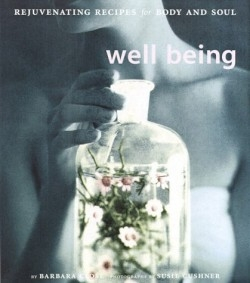Well Being
Rejuvenating Recipes for Body and Soul
This book is one to hold while sinking into a hot bath or sitting under the shade of a tree after a long, hectic day. Well Being is among a number of books about the resurgent interest in herbs, meditation, nutrition, exercise, yoga, massage, and self-help.
The beauty of this one is that it is not an exhaustive encyclopedia. It focuses largely on herbal healing, but doesn’t list every therapeutic herb and essential oil to be had on Earth. Instead, Close, founder of the holistic spa Naturopathica in East Hampton, New York, provides simple recipes to treat everyday ailments. She’s also narrowed the list of salves, oils, and medicinal teas to those made from herbs that can be grown at home or are commonly available, along with easy instructions to make them.
Well Being is arranged to address health care needs that arise during each change of the season. The ideas are simple and luxuriant: A pear drink in spring, with warming, stimulating herbs including grated ginger, when changes in temperature make one susceptible to colds. An easy-to-make salve using oil infused with the common and just as easily grown garden flower calendula, with its anti-inflammatory properties to treat dry skin, including gardener’s hands. A lavender aperitif in the hot days of summer, when the fragrant flowers are at their peak, mixed with sugar, lemon, and vodka and served over crushed ice. A rosemary foot bath for hot swollen feet. A nutritious root salad in autumn, and recipes for infused oils to stock the winter medicine chest. A hearty garlic soup to ward off colds in winter, and a peppermint-thyme steam inhalation to ease congestion.
Close demystifies how to make the preparations that can be found in health food stores with short, clear instructions for making tea, infusions (stronger teas), decoctions (teas made with roots and bark), tinctures (herbs steeped in alcohol), infused oils (herbs steeped in oil), ointments, and salves.
The book also is filled with helpful lists: medicinal herbs that grow well in window boxes; oils such as safflower, sweet almond, and jojoba used to dilute concentrated essential oils to avoid skin irritation; and different ways to use oils, from massage to compresses to saunas. There’s an essential oil first aid kit with each herb’s properties (antiseptic, antiviral, antibacterial, anti-inflammatory, diuretic, antibiotic, immune boosting, sedative, muscle relaxing, skin soothing) with cautions if, for example, an herb is a skin irritant or pregnant women should avoid it.
A certified aromatherapist and author of another book on that specialty, Close urges “get back in touch with our inner mad scientist” by blending oils for different effect. For example, she says, the scent of citrus oils are uplifting and an antidepressant in the dark months before spring.
She often offers time-saving tips. A calming lavender bath calls for steeping a half cup of fresh lavender blossoms in four cups of boiling water and then pouring the strained infusion into the bathtub. Too tired to make the infusion? Then simply add five to six drops of lavender essential oil into the tub.
Close says Western medicine looks at symptoms and tries to treat them, rather than allowing a person to pay attention to the symptoms and what they might be saying about a need for change. She similarly castigates some alternative approaches as being part of a “quick fix” mind-set, such as punishing dietary regimens, invasive measures such as colon therapy, excessive exercise routines, or overzealous intake of the latest dietary supplements.
Her “recipes” for well being aren’t limited just to herbs. She also gives gentle, brief reminders: The mind and body are nourished by even small doses of meditation, quiet, and stillness. Beneficial exercise can be a simple walk rather than a trip to the gym. Many headaches will recur if they’re only treated by swallowing bottles of painkillers instead of identifying the stress that likely is causing them.
Finally, she lists other books that give even more detail on nutrition, meditation, and cultivating and preparing herbs. Her book, though, is good for those who have long been interested in herbs but never seem to get around to actually using them. A person who receives this book as a gift might actually give it a try.
The book, measuring a little over seven by eight inches, feels good to hold in the hand. The color and black and white photographs of herbs and herbal preparations by Boston-based photographer Cushner, whose work has appeared in Garden Design magazine and other publications, help set the mood and provide inspiration. (July
Reviewed by
Diane Conners
Disclosure: This article is not an endorsement, but a review. The publisher of this book provided free copies of the book to have their book reviewed by a professional reviewer. No fee was paid by the publisher for this review. Foreword Reviews only recommends books that we love. Foreword Magazine, Inc. is disclosing this in accordance with the Federal Trade Commission’s 16 CFR, Part 255.

